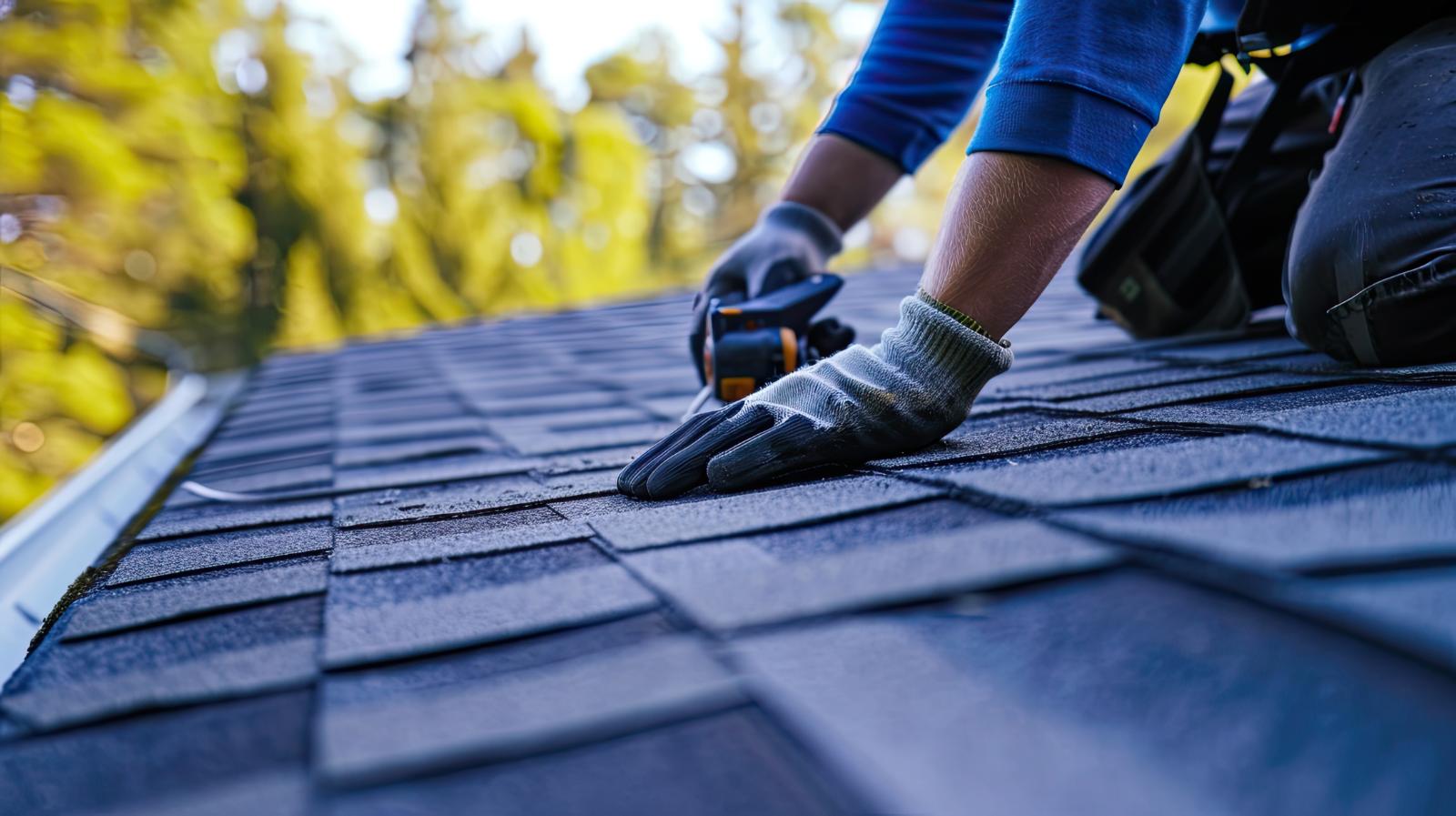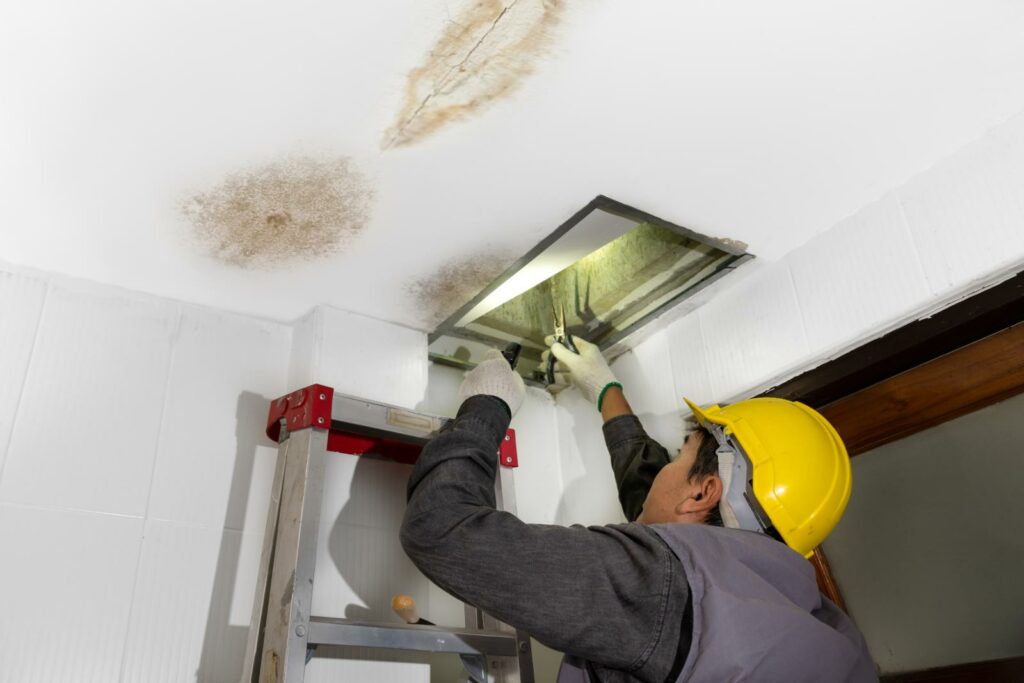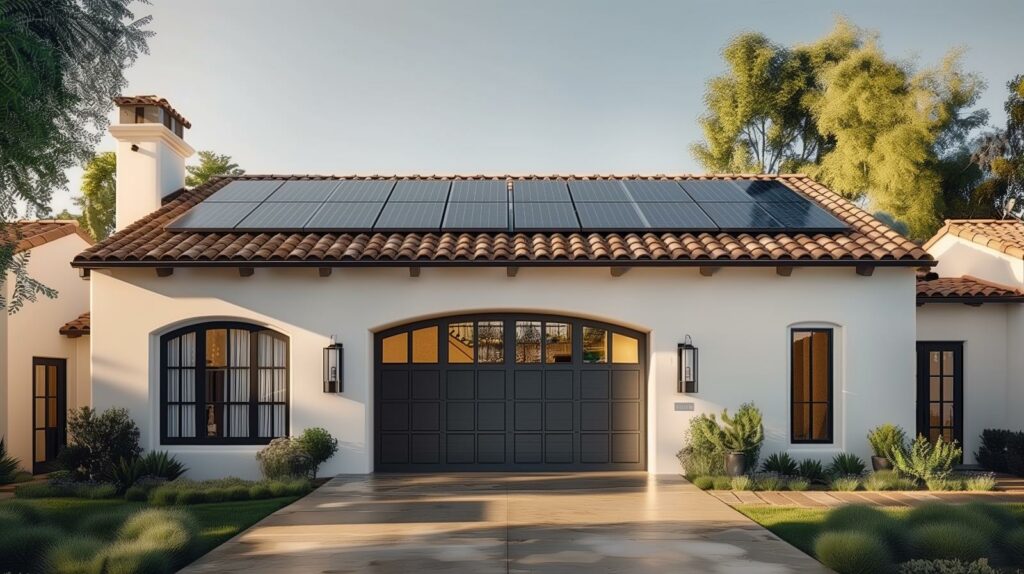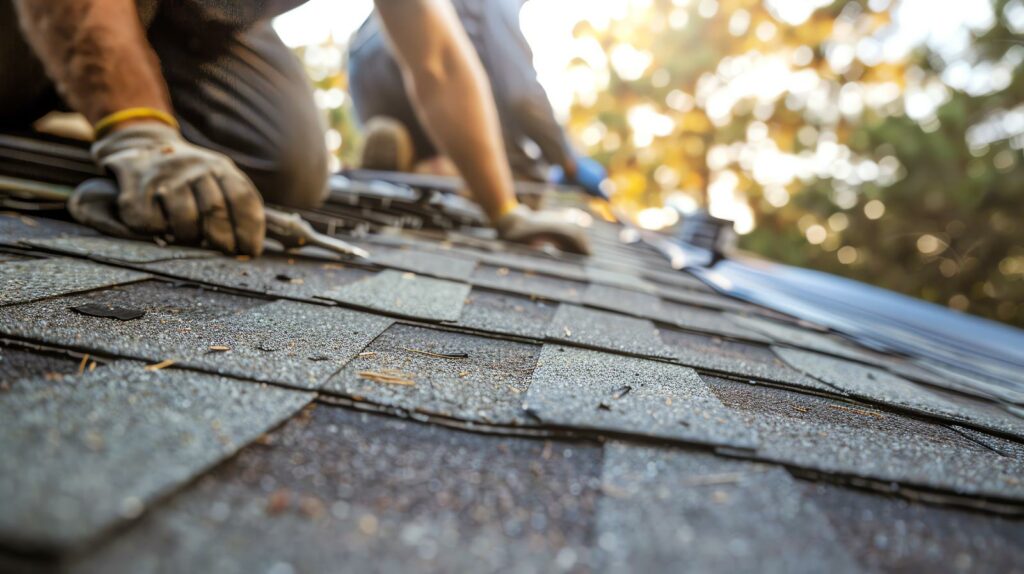Contents
You might think that a small leak in your roof isn’t a big deal, but hidden roof leaks demand your immediate attention. These sneaky leaks can cause extensive damage without you even realizing it. The longer they go unnoticed, the more havoc they wreak behind the scenes. Curious to know how these seemingly harmless leaks can turn into a homeowner’s nightmare? Let’s uncover the reasons why hidden roof leaks should be at the top of your repair list.
Key Takeaways
- Hidden roof leaks can cause structural damage if left untreated.
- Addressing leaks promptly prevents further interior damage.
- Undetected leaks lead to decreased insulation efficiency and increased energy costs.
- Prompt repairs maintain the property’s stability and energy efficiency.
- Professional inspection helps identify and fix hidden leaks efficiently.
Damp Spots on Ceilings
When inspecting damp spots on ceilings, prioritize locating the source of the leak to prevent further damage. Roof inspection is vital in identifying the area where water seeps through. Begin by examining the attic for any signs of water intrusion, such as stained insulation or drip marks on the rafters. Carefully inspect the roof for missing shingles, cracked flashing, or damaged seals around vents and chimneys. These are common areas where leaks can occur.
To ensure a lasting solution, opting for professional repair services is essential. A professional roofer will have the expertise to accurately diagnose the issue and recommend the most suitable course of action. Whether it requires a minor patch or a more extensive repair, entrusting the job to a professional will provide a thorough and effective solution. Remember, addressing roof leaks promptly can prevent costly repairs down the line and preserve the integrity of your home.
Peeling Paint or Wallpaper
Inspect your walls carefully for peeling paint or wallpaper in order to identify potential signs of hidden roof leaks that may require prompt attention. Peeling paint or wallpaper can be indicative of water damage from a roof leak that has seeped into the walls. Addressing this issue promptly can prevent further interior damage and more extensive repairs. Here are some maintenance tips to take into account when dealing with peeling paint or wallpaper:
| Maintenance Tips | Description | Benefits | Time Required |
|---|---|---|---|
| Check for Stains | Look for water stains on walls near the ceiling. | Early detection can prevent mold growth. | 10 minutes |
| Inspect Roof | Check the roof for missing or damaged shingles. | Fixing roof issues promptly can prevent leaks. | 30 minutes |
| Repair Leaks | Seal any identified leaks in the roof. | Prevent further water damage. | 1-2 hours |
| Repaint or Re-wallpaper | After addressing the leak, repaint or re-wallpaper the affected area. | Restoring the aesthetics of the room. | 2-3 hours |
Musty Odors in the Attic
To address musty odors in your attic effectively, begin by conducting a thorough inspection of the space for any signs of mold or mildew growth. Mold and mildew can thrive in moist environments, often caused by poor ventilation systems or inadequate attic insulation. Proper ventilation is essential to prevent moisture buildup, which can lead to musty smells and potential health hazards. Check for any leaks in the roof that may be allowing water to seep into the attic, creating the perfect breeding ground for mold.
In addition to checking for visible signs of mold, pay attention to any damp spots or water stains on the attic ceiling or walls. These could indicate a hidden leak that needs immediate attention. Make sure that your attic insulation is in good condition as well, as damaged insulation can retain moisture and contribute to the development of musty odors.
Water Stains on Walls
If you notice water stains on your walls, it’s important to investigate the source promptly to prevent further damage and potential mold growth. Water stains on walls are often an indication of a hidden roof leak that’s seeping through your home’s structure. Ignoring these stains can lead to serious interior damage and compromise the structural integrity of your property.
Water stains on walls should never be overlooked, as they can worsen over time, causing paint to bubble, plaster to deteriorate, and drywall to weaken. Beyond the visible damage, untreated leaks can also lead to mold growth, posing health risks to you and your family.
To effectively address water stains, it’s essential to locate and repair the source of the leak as soon as possible. By taking swift action, you can prevent further interior damage and safeguard your home’s structural integrity. Remember, addressing water stains promptly is key to maintaining a safe and healthy living environment.
Sagging or Warped Roof Deck
A sagging or warped roof deck is a concerning issue that requires immediate attention to prevent further structural damage to your property. When you notice your roof deck isn’t as straight and sturdy as it should be, it could be an indication of significant underlying problems that need to be addressed promptly. To assess the extent of the issue, a thorough roof inspection by a professional is essential.
Ignoring a sagging or warped roof deck can lead to more severe structural damage to your home. The deck plays an important role in supporting the weight of your roof, and any deformities can compromise the integrity of the entire structure. Over time, this could result in costly repairs and even pose safety risks to you and your family.
Therefore, if you observe any signs of a sagging or warped roof deck, it’s imperative to act swiftly to prevent further deterioration. By addressing this issue promptly, you can avoid more extensive damage and maintain the long-term stability of your property.
Mold Growth in Home
Understanding the risks associated with mold growth in your home is vital as a homeowner.
Mold not only poses health concerns but can also cause structural damage to your property.
Taking proactive measures to prevent mold growth is essential to maintaining a healthy and safe living environment for you and your family.
Mold Risks in Homes
Mold growth in homes poses significant health risks and can lead to costly structural damage if left untreated. When moisture seeps into your home, whether through hidden roof leaks or other sources, it creates the perfect environment for mold to thrive.
Mold spores can become airborne and infiltrate your indoor air, triggering respiratory issues and allergies. To prevent mold growth, focus on moisture control. Repair any leaks promptly, maintain proper ventilation in bathrooms and kitchens, and sustain ideal humidity levels.
Health Concerns From Mold
Taking proactive steps to address mold growth in your home is essential for safeguarding your health and the structural integrity of your property. Mold can lead to allergen exposure, triggering respiratory issues in individuals sensitive to mold spores. The presence of mold can have a substantial impact on indoor air quality, affecting the overall well-being of you and your family.
Additionally, mold growth is often a sign of underlying water damage, which, if left unchecked, can result in costly repairs and further health hazards. By promptly addressing mold growth in your home, you can mitigate the risks associated with allergens, respiratory problems, and potential structural damage, ensuring a safe and healthy living environment for you and your loved ones.
Preventing Mold Growth
To prevent mold growth in your home, it’s essential to address any moisture issues promptly and effectively. Moisture control is vital in preventing mold from thriving in hidden corners of your house. Make sure that any leaks or condensation are fixed promptly to eliminate potential breeding grounds for mold.
Ventilation strategies play a key role in keeping moisture levels in check. Proper ventilation in areas prone to dampness, such as bathrooms, kitchens, and basements, can help prevent mold growth. Consider using exhaust fans, opening windows when possible, and utilizing dehumidifiers in areas with high humidity levels.
Increased Energy Bills
If you have noticed a sudden rise in your energy bills, hidden roof leaks could be the culprit. These leaks allow warm or cool air to escape, leading to increased energy usage as your HVAC system works harder to maintain the desired temperature. Below is a table illustrating how hidden roof leaks impact your energy bills:
| Effects of Hidden Roof Leaks on Energy Bills | |
|---|---|
| Issue | Impact |
| Decreased Insulation Efficiency | Higher heating/cooling costs |
| HVAC Strain | Increased energy consumption |
| Drafts and Temperature Fluctuations | Uneven heating/cooling distribution |
When your roof has undetected leaks, the insulation in your attic gets wet, reducing its effectiveness and causing your HVAC system to strain. This results in higher energy bills as your system attempts to compensate for the lost energy. Additionally, drafts caused by leaks can lead to uneven temperature distribution, further increasing your energy consumption. Addressing hidden roof leaks promptly can help improve your home’s energy efficiency and reduce your monthly utility costs.
Recap
Now that you know the signs of hidden roof leaks and the importance of addressing them promptly, don’t delay taking action. Remember, like a ticking time bomb, these leaks can wreak havoc on your property if left unchecked.
Stay vigilant, stay proactive, and protect your home from the silent threat above. Stay ahead of the game, and keep your roof leak-free for a safe and sound living environment.




